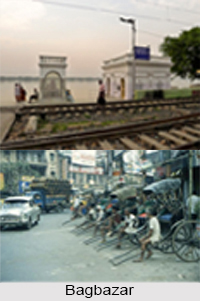 Bagbazar is vicinity in northern part of Kolkata after Shyambazar. This place is well known for Mayer bari or the House of Maa Sarada, the wife Shri Ramkrishna Paramahamsa.
Bagbazar is vicinity in northern part of Kolkata after Shyambazar. This place is well known for Mayer bari or the House of Maa Sarada, the wife Shri Ramkrishna Paramahamsa.
Location of Bagbazar
Bagbazar is a place administered under Shyampukur police station of Kolkata Police. It has been, along with neighbouring Shyambazar, the citadel of the Bengali aristocracy. Bagbazar has played an active role in growth and development of Kolkata during the time of British Government in India.
Naming of Baghbazar
The name, Bagbazar, is derived from two words put together from old Bengali literature: "bagh" meaning flower garden and "bazaar" meaning market. So it refers to a place where flowers are abundant.
History of Bagbazar
Sutanuti was gradually abandoned by the English people, when Kolkata emerged as the administrative seat in India. There remained, near its northernmost corner, Perin"s Garden, a pleasure resort, where once it was the height of gentility for the British East India Company"s covenanted servants to take their ladies for an evening stroll or moonlight fete. However, it was little frequented from around 1746 and by 1752 was sold for Rs.25,000. Captain Perin was owner of several ships. In 1754, Colonel C.F. Scott began manufacturing gunpowder at the garden. The old Chitpur Road (renamed Rabindra Sarani) was for many years the life line of Bagbazar. It followed the same track as the old pilgrim path built by Sabarna Roy Choudhury from Halisahar to Barisha.
Tram Tracks in Bagbazar
There are the tram tracks along Rabindra Sarani that came to Bagbazar in 1904 and are being renewed in 2007. While Rabindra Sarani cuts across Bagabazar from north to south, Bagbazar Street cuts across from Bagbazar Ghat in the west to Bidhan Sarani in the east. Girish Avenue is an extension of Chittaranjan Avenue. When it was built in the 1930s, a portion of the house of Girish Chandra Ghosh was spared and stands in the middle with the two flanges of the road on both sides of the house. There are numerous lanes and by-lanes in Bagbazar.
Visiting Information
Bagbazar is on the Kolkata Circular Railway. Shyambazar station of Kolkata Metro is within walking distance from most parts of Bagbazar.



















